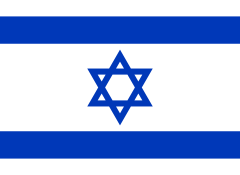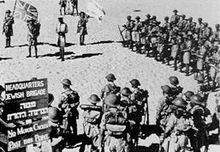Flag of Israel: Difference between revisions
MV dubious trivia from the Intro into new Controversies section |
removing a lot of stuff that has nothing to do with the flag of israel and everything to do with overemphasizing the feverish imaginations of a few zionist leaders |
||
| Line 36: | Line 36: | ||
=== Claims of "Nile to Euphrates" territorial ambitions === |
=== Claims of "Nile to Euphrates" territorial ambitions === |
||
It has been alleged by some groups that the blue stripes on the Israeli flag actually represent the rivers [[Nile]] and [[Euphrates]], which some Zionist thinkers (such as [[Avraham Stern]] and [[Israel Eldad]]) had claimed as the boundaries of [[land of Israel|Eretz Yisrael]], the land [[Promised land|promised]] to the [[Jew]]s by [[God]]. Those making this allegation insist that the flag "secretly" represents the desire of Jews to conquer all of the land between the Nile and Euphrates rivers, which would involve conquering and ruling over much of Egypt, all of Jordan, and some of Syria and Iraq. |
It has been alleged by some groups that the blue stripes on the Israeli flag actually represent the rivers [[Nile]] and [[Euphrates]], which some Zionist thinkers (such as [[Avraham Stern]] and [[Israel Eldad]]) had claimed as the boundaries of [[land of Israel|Eretz Yisrael]], the land [[Promised land|promised]] to the [[Jew]]s by [[God]]. Those making this allegation insist that the flag "secretly" represents the desire of Jews to conquer all of the land between the Nile and Euphrates rivers, which would involve conquering and ruling over much of Egypt, all of Jordan, and some of Syria and Iraq. [[Yasser Arafat]] in a September, [[1988]] interview with [[Playboy|Playboy Magazine]] also made the allegation and repeatedly tied this notion to the stripes on the Israeli flag.[http://sicsa.huji.ac.il/1rubin.htm][http://www.haaretz.com/hasen/pages/ShArt.jhtml?itemNo=501543&contrassID=1] |
||
This allegation that Jewish territorial ambitions include all the land from the Nile to the Euphrates has been popular in [[Arab]] literature since the [[1940s]]. [[Amin al-Husayni]], former [[Mufti]] of [[Jerusalem]] stated: |
|||
:''The Palestine tragedy is unequaled in history. The Zionist imperialistic plot against Palestine was most inhumane and base. World Judaism plans to take over most of the Arab countries to fulfill its so-called historical dream of a homeland between the Nile and Euphrates. The Imperialist Jewish plot is not aimed at Palestine only...'' |
|||
In 1997, the Iranian parliamentary speaker Ali Akbar Nateq Nuri accused the Jews of attempting to live out a "Nile-to-Euphrates dream." The Hamas Charter explicitly states (in article 32) "After Palestine, the Zionists aspire to expand from the Nile to the Euphrates."[http://www.yale.edu/lawweb/avalon/mideast/hamas.htm] [[Yasser Arafat]] in a September, [[1988]] interview with [[Playboy|Playboy Magazine]] also made the allegation and repeatedly tied this notion to the stripes on the Israeli flag.[http://sicsa.huji.ac.il/1rubin.htm][http://www.haaretz.com/hasen/pages/ShArt.jhtml?itemNo=501543&contrassID=1] |
|||
Both [[Zionism|Zionist]] and [[Anti-Zionism|anti-Zionist]] authors have debunked the claim that the stripes on the flag represent territorial ambitions. In his article "Imperial Israel: The Nile-to-Euphrates Calumny" in the March, [[1994]] ''Middle East Quarterly'' [[Daniel Pipes]] notes "In fact, the blue lines derive from the design on the traditional Jewish prayer shawl."[http://www.meforum.org/article/215]. [[Danny Rubenstein]], writing in ''[[Ha'aretz]]'', notes "...Arafat... added, in interviews that he gave in the past, that the two blue stripes on the Israeli flag represent the Nile and the Euphrates... No Israeli, even those who demonstrate understanding for Palestinian distress, will accept the... nonsense about the blue stripes on the flag, which was designed according to the colors of the traditional tallit (prayer shawl)..."[http://www.haaretz.com/hasen/pages/ShArt.jhtml?itemNo=501543&contrassID=1] Persistent critic of Israel and Zionism [[Israel Shahak]] is equally explicit. In his ''The Zionist Plan for the Middle East'' he states |
Both [[Zionism|Zionist]] and [[Anti-Zionism|anti-Zionist]] authors have debunked the claim that the stripes on the flag represent territorial ambitions. In his article "Imperial Israel: The Nile-to-Euphrates Calumny" in the March, [[1994]] ''Middle East Quarterly'' [[Daniel Pipes]] notes "In fact, the blue lines derive from the design on the traditional Jewish prayer shawl."[http://www.meforum.org/article/215]. [[Danny Rubenstein]], writing in ''[[Ha'aretz]]'', notes "...Arafat... added, in interviews that he gave in the past, that the two blue stripes on the Israeli flag represent the Nile and the Euphrates... No Israeli, even those who demonstrate understanding for Palestinian distress, will accept the... nonsense about the blue stripes on the flag, which was designed according to the colors of the traditional tallit (prayer shawl)..."[http://www.haaretz.com/hasen/pages/ShArt.jhtml?itemNo=501543&contrassID=1] Persistent critic of Israel and Zionism [[Israel Shahak]] is equally explicit. In his ''The Zionist Plan for the Middle East'' he states |
||
Revision as of 01:20, 8 February 2006

| State of Israel |
|---|
 |
The flag of Israel was adopted on October 28, 1948, five months after the nation's independence. It depicts a blue Star of David on a white background, between two horizontal blue stripes. The color blue is mandated only as 'sky blue,' and the shade varies from flag to flag. Sometimes it is a dark, almost navy blue, other times it is a very light blue.
Origin of the flag
The flag of the State of Israel is intended to portray a Star of David on a tallit, the traditional Jewish prayer shawl.
The Israelites used an indigo colored dye called tekhelet; this dye is now believed to have been made from the snail murex trunculus. This dye was very important in both Jewish and non-Jewish cultures of this time, and was used by royalty and the upper class in dyeing their clothing, sheets, curtains, etc. This dye is known as Tyrian purple.
In the Torah, the Israelites are commanded to dye one of the threads of their tallit (prayer shawl) with tekhelet; when they look at this dye they will think of the blue sky, and of the God above them in Heaven. Tekhelet corresponds to the color of the divine revelation (Midrash Numbers Rabbah xv.). Sometime near the end of the Talmudic era (500-600 CE) the industry which produced this dye collapsed. It became rarer and rarer; over time the Jewish community lost the tradition of which species of shellfish produced this dye. Since Jews were then unable to fulfill this commandment, they have since left their tzitzit (tallit strings) white. However, in remembrance of the commandment to use the tekhelet dye, it became common for Jews to have blue or purple stripes on their tallit. [1] [2] The idea that the blue and white colors were the national colors of the Jewish people was early on voiced by Ludwig August Frankl (1810-1894), an Austrian Jewish poet. In his poem, "Judah's Colors", he writes:
- When sublime feelings his heart fill, he is mantled in the colors of his country. He stands in prayer, wrapped in a sparkling robe of white.
- The hems of the white robe are crowned with broad stripes of blue; Like the robe of the High Priest, adorned with bands of blue threads.
- These are the colors of the beloved country, blue and white are the borders of Judah; White is the radiance of the priesthood, and blue, the splendors of the firmament. (A. L. Frankl, Juda's Farben, in Ahnenbilder (Leipzig, 1864), p. 127)
In 1885 the agricultural village of Rishon LeZion used a blue and white flag to mark its third anniversary. A blue and white flag, with a Star of David and the Hebrew word "Maccabee", was used in 1891 by the Bnai Zion Educational Society.
David Wolffsohn (1856-1914), a businessman prominent in the early Zionist movement, was aware that the nascent Zionist movement had no official flag, and that the design proposed by Theodore Herzl was gaining no significant support. He writes:
- At the behest of our leader Herzl, I came to Basle to make preparations for the Zionist Congress. Among many other problems that occupied me then was one which contained something of the essence of the Jewish problem. What flag would we hang in the Congress Hall? Then an idea struck me. We have a flag — and it is blue and white. The talith (prayer shawl) with which we wrap ouselves when we pray: that is our symbol. Let us take this Talith from its bag and unroll it before the eyes of Israel and the eyes of all nations. So I ordered a blue and white flag with the Shield of David painted upon it. That is how the national flag, that flew over Congress Hall, came into being.
While this flag emphasizes Jewish religious symbols, Theodor Herzl wanted the flag to have more universal symbols: 7 golden stars symbolizing the 7-hour working quota of the enlightened state-to-be, which would have advanced socialist legislations.

Controversies
Today it has been known to be the most burned flag in the world (especially in the Middle East and Europe where it is often burned in partners with the United States flag).
Claims of "Nile to Euphrates" territorial ambitions
It has been alleged by some groups that the blue stripes on the Israeli flag actually represent the rivers Nile and Euphrates, which some Zionist thinkers (such as Avraham Stern and Israel Eldad) had claimed as the boundaries of Eretz Yisrael, the land promised to the Jews by God. Those making this allegation insist that the flag "secretly" represents the desire of Jews to conquer all of the land between the Nile and Euphrates rivers, which would involve conquering and ruling over much of Egypt, all of Jordan, and some of Syria and Iraq. Yasser Arafat in a September, 1988 interview with Playboy Magazine also made the allegation and repeatedly tied this notion to the stripes on the Israeli flag.[3][4]
Both Zionist and anti-Zionist authors have debunked the claim that the stripes on the flag represent territorial ambitions. In his article "Imperial Israel: The Nile-to-Euphrates Calumny" in the March, 1994 Middle East Quarterly Daniel Pipes notes "In fact, the blue lines derive from the design on the traditional Jewish prayer shawl."[5]. Danny Rubenstein, writing in Ha'aretz, notes "...Arafat... added, in interviews that he gave in the past, that the two blue stripes on the Israeli flag represent the Nile and the Euphrates... No Israeli, even those who demonstrate understanding for Palestinian distress, will accept the... nonsense about the blue stripes on the flag, which was designed according to the colors of the traditional tallit (prayer shawl)..."[6] Persistent critic of Israel and Zionism Israel Shahak is equally explicit. In his The Zionist Plan for the Middle East he states
- A good example is the very persistent belief in the non-existent writing on the wall of the Knesset of the Biblical verse about the Nile and the Euphrates. Another example is the persistent, and completely false declarations, which were made by some of the most important Arab leaders, that the two blue stripes of the Israeli flag symbolize the Nile and the Euphrates, while in fact they are taken from the stripes of the Jewish praying shawl (Talit).
Saqr Abu Fakhr, an Arab writer, has also spoken out against this idea. In his article "Seven Prejudices about the Jews" (published in the London-based pan-Arab daily Al-Hayat, November 12,13,14) he demonstrates that the "Nile to Euphrates" claim regarding the flag is one of seven popular misconceptions and/or myths about Jews which, despite being unfounded and having abundant evidence refuting them, continue to circulate in the Arab world.
Nevertheless, as recently as January 29, 2006, Hamas leader Mahmoud Zahar issued a demand for Israel to change its flag, citing the "Nile to Euphrates" argument.
Proposals to change the flag
It has recently been suggested that additional symbols be added to the flag with which non-Jewish citizens of Israel, such as Israeli Arabs, would be able to identify. Such proposals have not gathered any significant percentage of public support.
See also
References
G. Sholem, "The Curious History of the Six Pointed Star; How the 'Magen David' Became the Jewish Symbol," Commentary, 8 (1949) pp. 243-351.
External link
